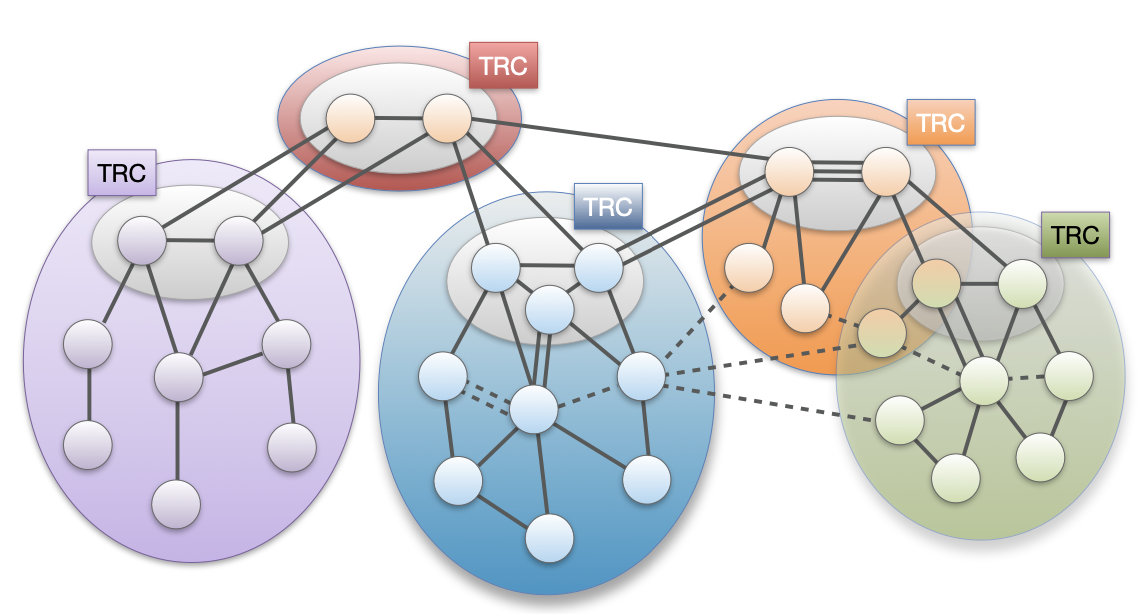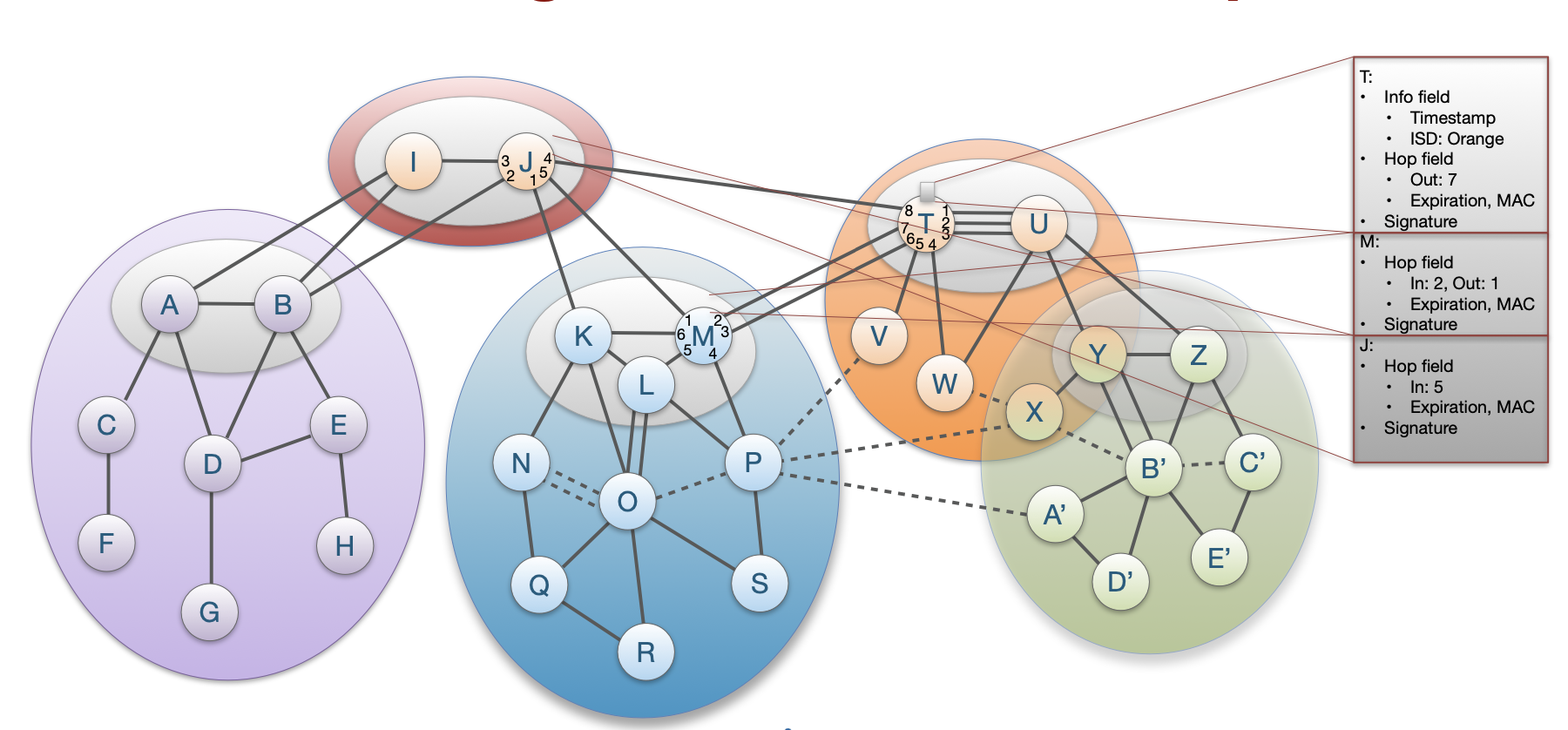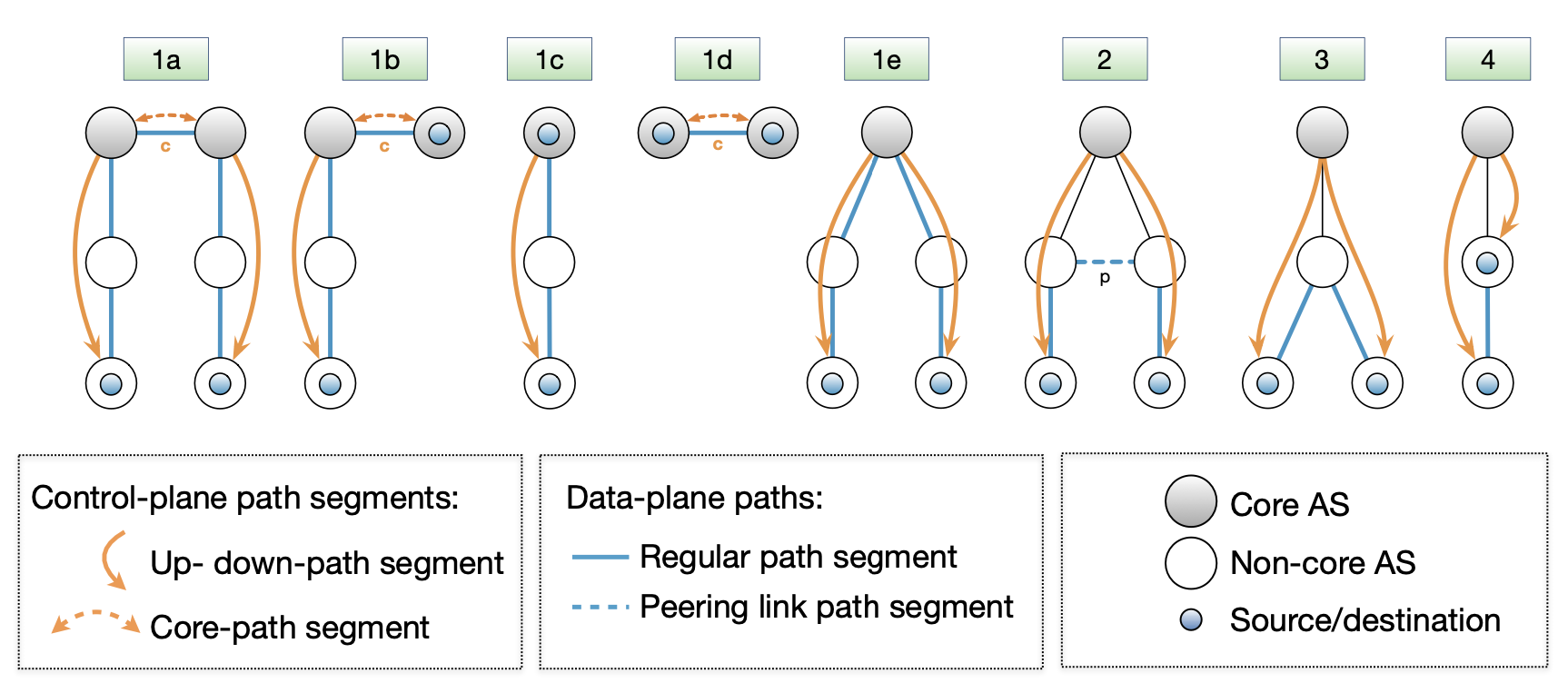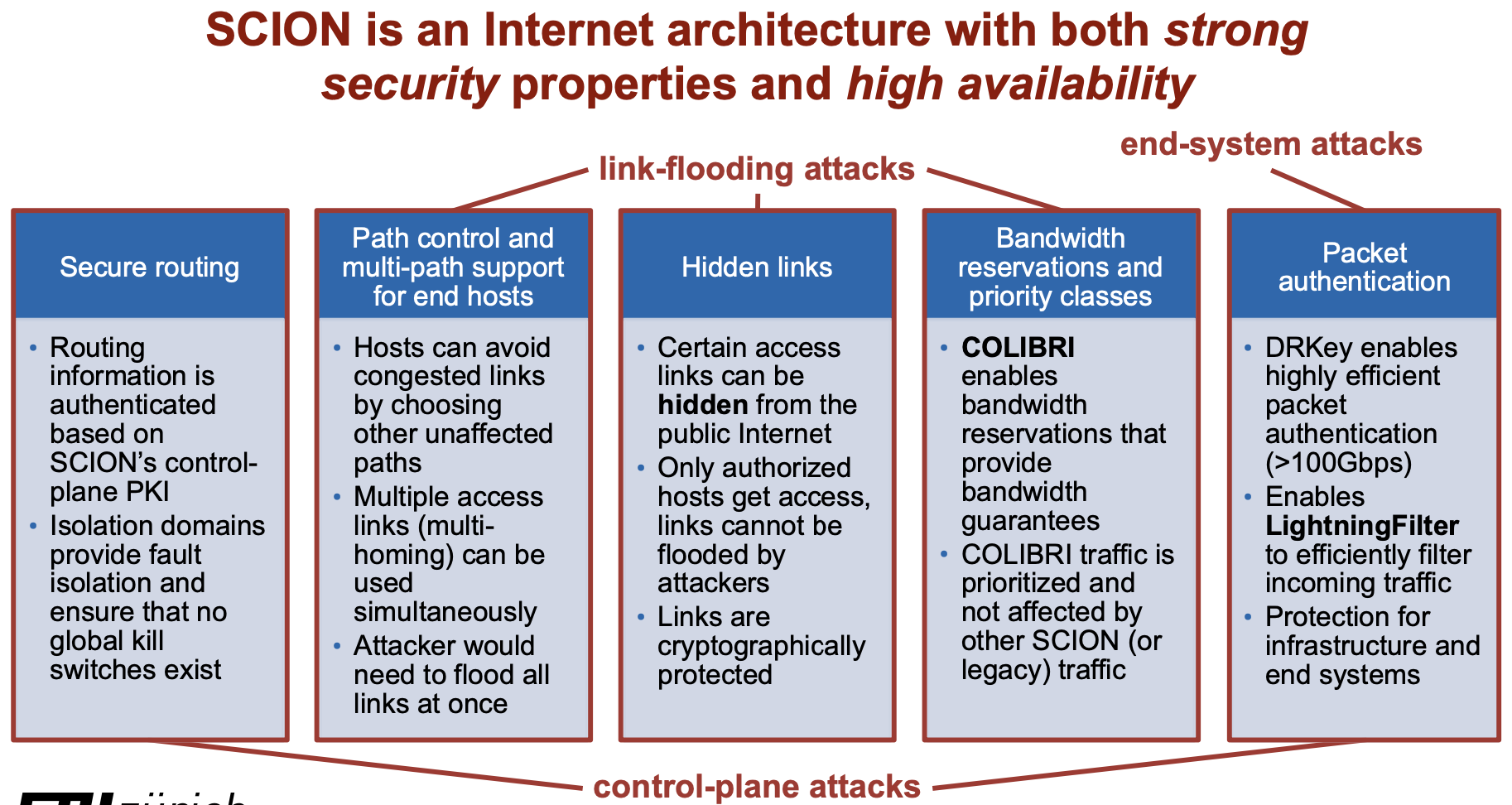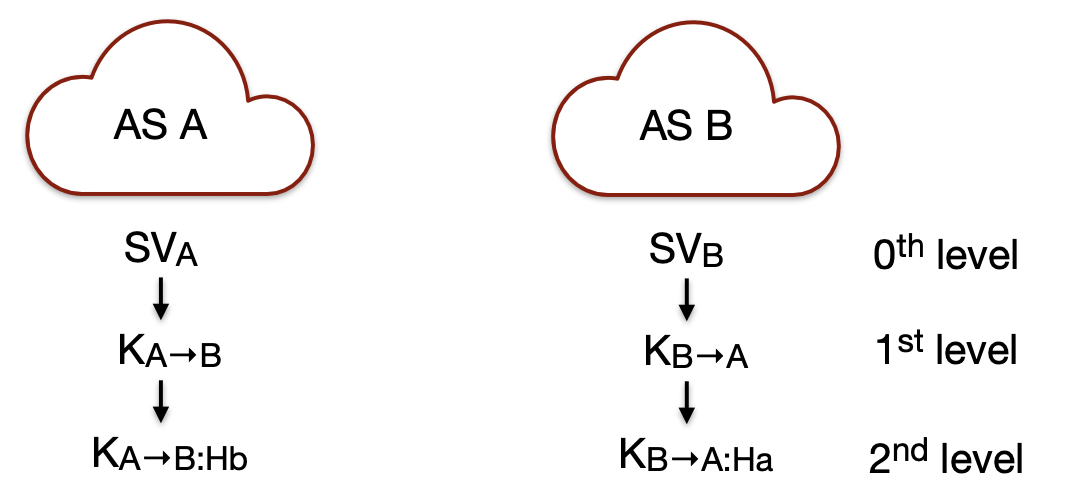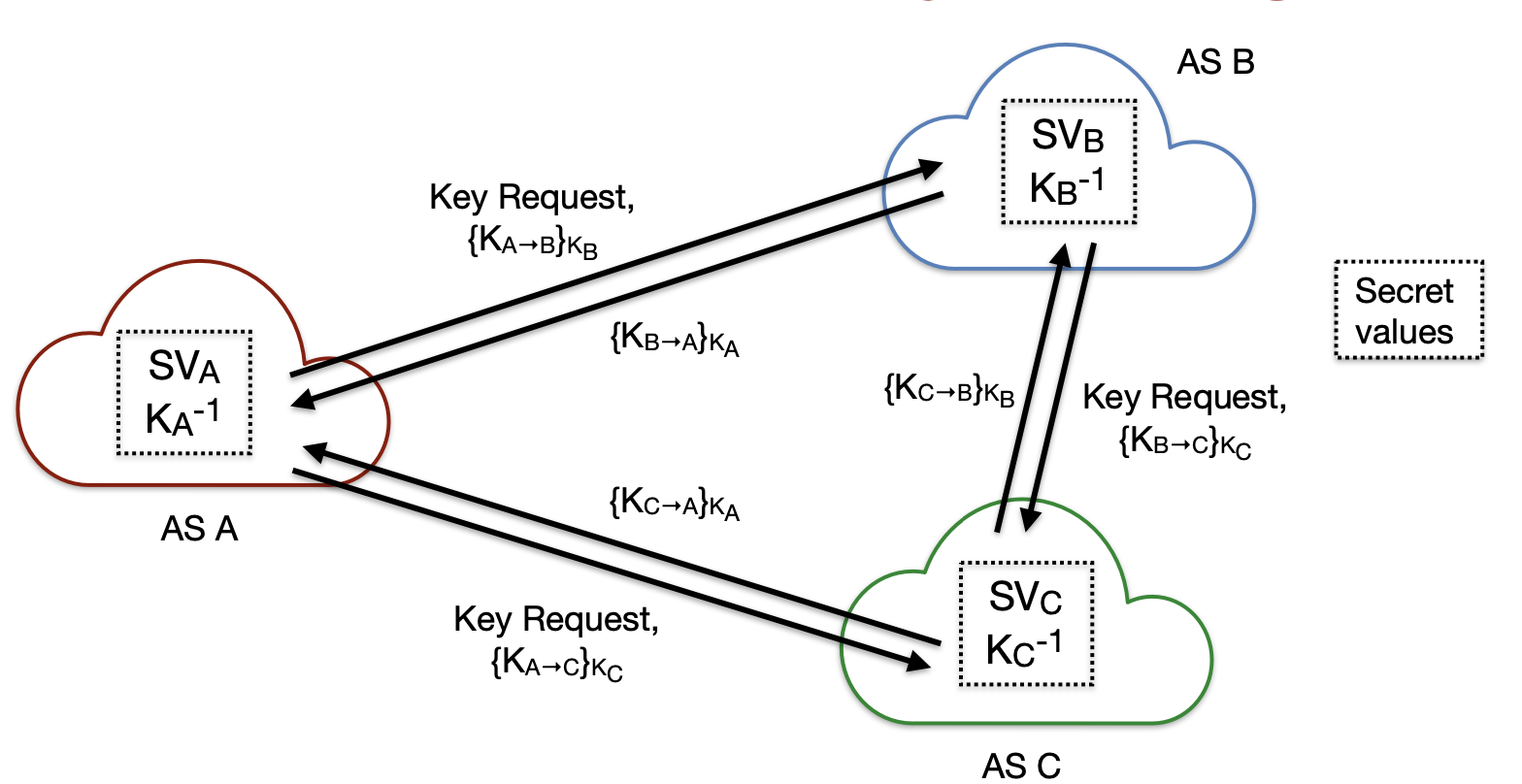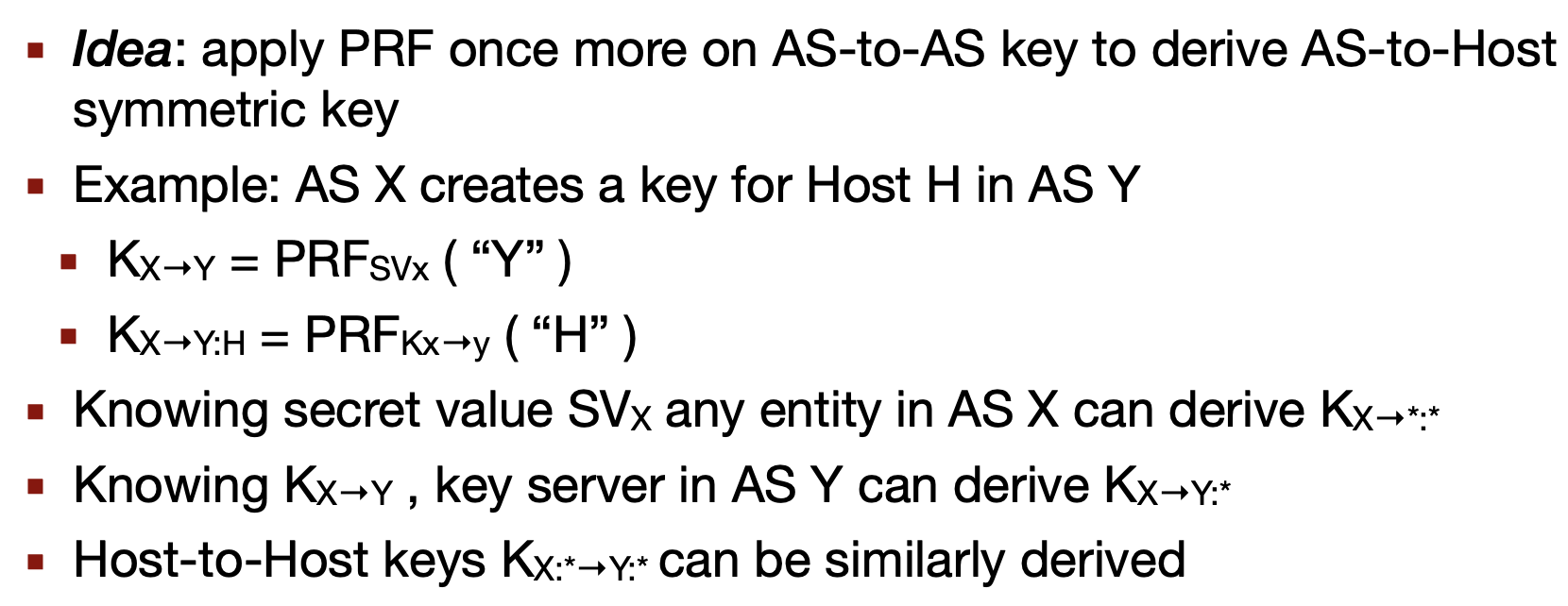SCION
SCION
Introduction
Global communication guarantees can be achieved as long as a path composed of benign domains exists.
During our journey we discovered that path-aware networking and multi-path communication are powerful concepts that can provide higher efficiency than a single-path Internet:
- Enables path optimization depending on application needs
- Simultaneous use of several paths unlocks additional bandwidth
SCION Architecture Principles
- Stateless Packet Forwarding
- No inconsistent forwarding state
- “Instant convergence” routing
- Path-aware networking
- Multi-path communication
- High security through design and formal verification
- Sovereignty and transparency for trust roots
Approach for Scalability
- Isolation Domain (ISD): grouping of ASes
- ISD Core: ASes that manage the ISD and provide global connectivity
- Core AS: AS that is part of the ISD Core
Path-based Network Architecture
- Control Plane - Routing
- Constructs and disseminates path segments
- Data Plane - Packet Forwarding
- Combines Path Segments to Path
- Packets contain Path
- Routers forward packets based on Path
- Simpler routers, stateless operation
Intra-ISD Path Exploration: beaconing
Core ASes initiate Path-segment Construction Beacons (PCBs), which traverse ISD as a flood to reach downstream ASes.
Each AS receives multiple PCBs representing path segments to a core AS.
PCB Contents:
- PCB creation time
Each AS on path adds:
- AS name
- Hop field for data-plane forwarding
- Link identifiers
- Expiration time
- Message Authentication Code
- AS signature
Inter-ISD Path Exploration: core beaconing
Path Server Infrastructure
Path servers offer lookup service:
- ISD, AS → down-path-segments, core-path segments
- Local up-path segment request → up-path segments to core ASes
Core ASes operate core path server infrastructure:
- consistent, replicated storage of down-path segments and core-path segments
Each non-core AS runs local path servers:
- serves up-path segments to local clients
- resolves and caches response of remote AS lookups.
Up-Path Segment Registration
AS selects path segments to announce as up-path segments for local hosts. Up-path segments are registered at local path servers.
Down-Path Segment Registration
AS selects path segments to announce as down-path segments for others to use to communicate with AS. Down-path segments are uploaded to core path server in core AS.
**Communication within ISD**
The client obtains path segments:
- Up-path segments to local ISD core ASes (blue);
- Down-path segments to destination (green);
- Core-path segments as needed to connect up-path and down- path segments (orange).
The client then combines path segments to obtain end-to-end paths (yellow).
Communication to Remote ISD
Host contacts local path server requesting <ISD, AS>.
If path segments are not cached, local path server will contact core path server.
If core path server does not have path segments cached, it will contact remote core path server.
Finally, host receives up-, core- and down-segments.
Path Combination
Scion Control and Data Plane
The Control Plane has three main functions:
- Path exploration → path segments
- Path dissemination → senders request segments
- Certificate dissemination/renewal → needed for segment verification
Path segments contain forwarding and meta information. Meta information can include geographical location of routers, MTU, bandwidth, link latency.
Senders extract the forwarding information from the path segments to form complete end-to-end paths.
Forwarding information is encoded in the packet header. Routers only verify the authenticity of the information → two AES operations replace longest-prefix match.
Since addresses are tied to AS numbers, and the hop fields are authenticated with signatures, an off path attacker has no way to tamper with the routing process. In addition, forwarding is only based on the path in the packet header which cannot be influenced by off-path attackers.
SCION Drawbacks
Initial Latency Inflation
Bandwidth overhead due to paths in packets
Increased complexity in key management
Initial setup cost
**How to Deploy SCION:**
**ISP**
CORE Routers are set up at the borders of an ISP: to peer with other SCION-enabled networks and to collect customer accesses. No change to the internal network infrastructure of an ISP needed!
End Domain
SCION IP Gateway (SIG) enables seamless integration of SCION capabilities in end-domain networks.
No upgrades of end hosts or applications needed.
Dynamically Recreatable Key (DRKey)
Use a per-AS secret value to derive keys with an efficient Pseudo-Random Function
Key Server Infrastructure
Key servers that are deployed in each AS build the backbone of key hierarchy and they’re responsible for key exchange, local key establishment and key management.
After AS-level keys are established, symmetric keys for end hosts can be provided using key derivation.
Keys can be used to provide source authenticity of packets without costly key exchange between communicating parties.
Each host is required to contact their local key server.
Key Hierarchy
AS A creates key hierarchy from secret value A (SV_A) using a Pseudo-Random Function $K_{A\rightarrow B}=PRF_{SVA}(B)$.
Similarly, AS B creates key hierarchy based on SV_B
First-level Key Exchange
Second-level DRKey
DRKey Use Case: SCMP Authentication
Border router in AS B can derive key $K^{smcp}_{B\rightarrow A:source}$ from SV_B.
Host “Source” can fetch key from local key server KS_A to authenticate SCMP message
DRKey Use Case: LightningFilter
Approach: sender locally fetches remote LightningFilter’s key via DRKey; remote LightningFilter can derive key within a few milliseconds and can authenticate the packet.
Advantage: packet verification possible in less than 10 nanoseconds at a much lower overhead than heuristic-based firewalls.
LightningFilter History-based Filtering
Filtering service deployed upstream of protected end services.
It performs:
- Packet authentication with DRKey
- authentic source AS
- Duplicate suppression using Bloom Filter
- Per-AS history collection using Cuckoo hash table
- History-based resource allocation and filtering during DoS
- fair resource allocation based on historical usage
This results in a guaranteed service, as long as total number of requests from AS < allowed number of requests → collateral damage only for hosts within attacker-controlled AS.
EPIC: Every Packet Is Checked
Goals:
- Per-packet source authentication by every router and destination
- Per-packet unique hop fields
- Path validation by destination
Attacks prevents:
- Malicious router replays packets or increases packet size
- Hop field MAC is brute forced and destination attacked until expiration time
**Importance of Path Awareness & Multi-path**
Multi-Path Routing Approaches
For a powerful multi-path system, we need a rich set of path choices: ideally dozens of paths if possible.
Problem: most prior multi-path routing algorithms are based on BGP, offering only 2-3 different path choices.
- Overhead increases linearly in the number of paths hampering scalability
The path segment combination of SCION provides a rich set of path choices.
Admission Algorithm with per-neighbour fairness
Each AS defines neighbour-to-neighbour minimum bandwidth guarantees. For any path, AS-to-AS minimum bandwidth guarantee can be computed, regardless of other demands. Algorithm guarantees that no set of ASes can reserve a disproportionate amount of bandwidth through any link.
